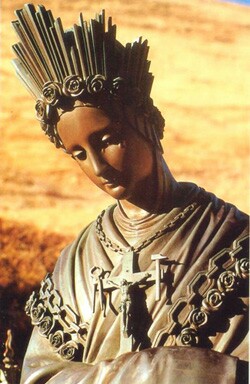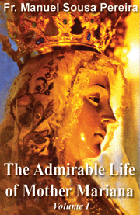What People Are Commenting
Burial of Nuns, Cross & Bishop Williamson
Are the Symbols on the Cross of La Salette Masonic?
Hi and blessings to you.
 I have been reading many wonderful articles on your site, and was reading about Our Lady of La Salette.
I have been reading many wonderful articles on your site, and was reading about Our Lady of La Salette.
Although not addressed, did you notice the cross Our Lady was wearing?
Do you realize that on each end of that cross are the symbols of Masonry. Here is a site that addresses masonry symbols, and note further down the page some pictures of them.
Why do you think our dear Mother would have these shown via that cross, as well as that very extraordinary heavy chain above her roses. I find these to be very, very interesting.
Have you or anyone else ever addressed this?
Thank you so much, and may you continue your wonderful work.
A.S.
TIA responds:
Hello A.S.,
Those are not symbols of Freemasonry, but the symbols of the Passion.
It is a common pious Catholic practice to represent the Cross with the tools of torture that caused the torments Our Lord suffered for us. Some crucifixes bear the three nails, the crown of thorns, the spear, the stick with a sponge, the whips, the hammer, the ladder used to take His Sacred Body from the Cross, the pincers used to pull out the nails. Others add the hand that slapped the Holy Face, the Tunic over which the soldier cast lots, Judas' pouch with 30 coins etc. The cock also is sometimes present among these symbols representing the betrayal of St. Peter.
Below, we display some of these pious crucifixes for you to compare with the one Our Lady wears at La Salette, which holds only the pincer and the hammer.
By the way, if you find crucifixes with skull and bones at the bottom, please, do not link this symbol with Freemasonry. The skull and bones at the bottom of a crucifix refer to a very old and holy tradition that the Cross of Our Lord Jesus Christ was set in the ground on the exact same place where Adam first stepped when he left Paradise. It was at that same place that his body was buried when he died. So, that skull and those bones represent those of Adam, whose sin was redeemed by the crucifixion of Christ.
In the last two rows of pictures are some crucifixes with the skull and bones.
We hope this will help you to become more familiar with Catholic symbols and traditions.
Cordially,
TIA correspondence desk


Although not addressed, did you notice the cross Our Lady was wearing?
Do you realize that on each end of that cross are the symbols of Masonry. Here is a site that addresses masonry symbols, and note further down the page some pictures of them.
Why do you think our dear Mother would have these shown via that cross, as well as that very extraordinary heavy chain above her roses. I find these to be very, very interesting.
Have you or anyone else ever addressed this?
Thank you so much, and may you continue your wonderful work.
A.S.
______________________
TIA responds:
Hello A.S.,
Those are not symbols of Freemasonry, but the symbols of the Passion.
It is a common pious Catholic practice to represent the Cross with the tools of torture that caused the torments Our Lord suffered for us. Some crucifixes bear the three nails, the crown of thorns, the spear, the stick with a sponge, the whips, the hammer, the ladder used to take His Sacred Body from the Cross, the pincers used to pull out the nails. Others add the hand that slapped the Holy Face, the Tunic over which the soldier cast lots, Judas' pouch with 30 coins etc. The cock also is sometimes present among these symbols representing the betrayal of St. Peter.
Below, we display some of these pious crucifixes for you to compare with the one Our Lady wears at La Salette, which holds only the pincer and the hammer.
By the way, if you find crucifixes with skull and bones at the bottom, please, do not link this symbol with Freemasonry. The skull and bones at the bottom of a crucifix refer to a very old and holy tradition that the Cross of Our Lord Jesus Christ was set in the ground on the exact same place where Adam first stepped when he left Paradise. It was at that same place that his body was buried when he died. So, that skull and those bones represent those of Adam, whose sin was redeemed by the crucifixion of Christ.
In the last two rows of pictures are some crucifixes with the skull and bones.
We hope this will help you to become more familiar with Catholic symbols and traditions.
Cordially,
TIA correspondence desk

______________________
Atila,
We are trying to make sense out of the SSPX/Resistance situation and looking where to turn.
Back in 2009 you wrote an article called "Piece of the pie" mentioning that Bishop Williamson was working with the other 3 bishops to bring traditionalists under modernist Rome.
Do you think that is still the case?
Can you expound on that, please?
Thanks.
B.W.
The Editor responds:
B.W.,
Thank you for your message.
I believe the maneuver described in that article has taken decades to be executed and, therefore, is still in course. The central point of that plan was/is to bring back to Rome as many traditionalists as SSPX has under its control.
If the merging of the three Bishops with the present day Vatican will take place – everything seems to be marching in this direction – then, it will be more or less inevitable that some people will not follow. Your email confirms it.
So, the principle of Lenin to control the reactions against his own cause applies. Lenin, in fact, reportedly affirmed: “Let us make the anti-Communism before the real anti-Communism starts.”
Analogously, the motto for the SSPX Bishops would be: “Let us make the reaction against our compromise before someone else starts it and we lose control.”
It seems to me that this is what has been applied. So, if I am not mistaken, Bishop Williamson would be in charge of leading this anti-compromise reaction.
But, at this phase of the process, what should be the characteristics of this leadership? It should be as gauche as possible in order to discourage the grassroots from following him and, instead, go along with the other three Bishops in their love story with the progressivist Vatican.
At this phase, indeed, Bishop Williamson seems to be committing all the errors necessary to alienate his grassroots:
When the assimilation of the SSPX by the Conciliar Church will be consummated, the guidelines for this leadership may change as well. Then, the objective would no longer be to push people to merge in a short time with Rome, as it is now. It would be to repeat the long loop started when Arch. Lefebvre ordained priests without the permission of Paul VI and was suspended a divinis. That is, again, it may adopt a more astute policy to attract good traditionalists and prevent them from following other leaders.
Here you have an update on that article, which in its essential lines continues to depict the full picture of what we are watching now.
Cordially,
Atila S. Guimarães
We are trying to make sense out of the SSPX/Resistance situation and looking where to turn.
Back in 2009 you wrote an article called "Piece of the pie" mentioning that Bishop Williamson was working with the other 3 bishops to bring traditionalists under modernist Rome.
Do you think that is still the case?
Can you expound on that, please?
Thanks.
B.W.
______________________
The Editor responds:
B.W.,
Thank you for your message.
I believe the maneuver described in that article has taken decades to be executed and, therefore, is still in course. The central point of that plan was/is to bring back to Rome as many traditionalists as SSPX has under its control.
If the merging of the three Bishops with the present day Vatican will take place – everything seems to be marching in this direction – then, it will be more or less inevitable that some people will not follow. Your email confirms it.
So, the principle of Lenin to control the reactions against his own cause applies. Lenin, in fact, reportedly affirmed: “Let us make the anti-Communism before the real anti-Communism starts.”
Analogously, the motto for the SSPX Bishops would be: “Let us make the reaction against our compromise before someone else starts it and we lose control.”
It seems to me that this is what has been applied. So, if I am not mistaken, Bishop Williamson would be in charge of leading this anti-compromise reaction.
But, at this phase of the process, what should be the characteristics of this leadership? It should be as gauche as possible in order to discourage the grassroots from following him and, instead, go along with the other three Bishops in their love story with the progressivist Vatican.
At this phase, indeed, Bishop Williamson seems to be committing all the errors necessary to alienate his grassroots:
- He is provoking the Vatican to excommunicate him again and label him Schismatic by consecrating two new Bishops with great fanfare;
- He is giving mixed orientation to those priests who broke with SSPX or were expelled from it by leading them into disunion, confusion and discouragement;
- He is advising some of his followers to go to Novus Ordo Masses if they believe it is right and does good for their souls;
- He is protecting under his wings a flagrant pedophile priest, causing scandal among not a few priests and laymen;
- He continues to defend extravagant social/moral/religious points, such as to present the Muslins as a reservoir of natural law and civilization for the future; to sponsor an aggressive misogynism and place women in embarrassing lower positions; to promote controversial and condemned works such as the Poem of the Man God by Maria Valtorta.
When the assimilation of the SSPX by the Conciliar Church will be consummated, the guidelines for this leadership may change as well. Then, the objective would no longer be to push people to merge in a short time with Rome, as it is now. It would be to repeat the long loop started when Arch. Lefebvre ordained priests without the permission of Paul VI and was suspended a divinis. That is, again, it may adopt a more astute policy to attract good traditionalists and prevent them from following other leaders.
Here you have an update on that article, which in its essential lines continues to depict the full picture of what we are watching now.
Cordially,
Atila S. Guimarães

Posted May 24, 2016


















I hope you can help. With the closure of the Carmel Convent in Chichester, West Sussex, England, in 1994 the 37 nuns interred there were exhumed and taken to another burial site. During the excavation work it was discovered that some of the nuns had coffins, others not. The earlier burials, from 1857, seemed to be without coffins and only the later interments, from around WWII onwards had coffins.
Was there a standard practice, changed in later years?
The reason for my inquiry?
I'm writing the history of the convent from its origins to its closure.
Kind regards.
Ken Rimell
TIA responds:
Hello Ken Rimell,
Thank you for the consideration in sending your question.
As far as we know, there is liberty to bury the members of Carmelite Order either in coffins or directly in the ground according to the custom of the area and the demands of its sanitary civil authorities. However, we did not have time to make a specific search on this topic.
Maybe you can find more on this matter in one of the following books that deal with:
* Carmelite writers who address the history of monasteries and convents in England, here,
* The Carmelite rule and tradition, here.
Cordially,
TIA correspondence desk